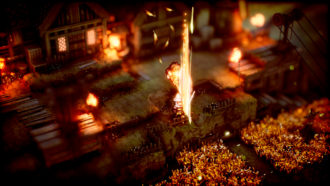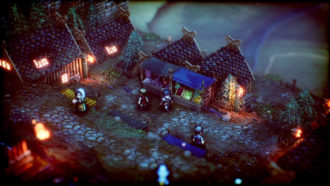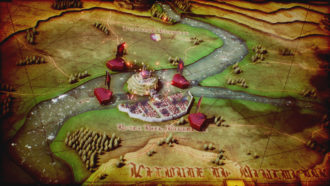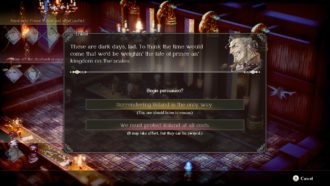Platform:
Nintendo Switch
Released:
March 4, 2022
Publisher:
Nintendo
Developers:
Square Enix, Artdink
Have you ever experienced a video game so grandiose in nature you’re thinking about it for quite the time after? A title that has both a story that feels epic, while also displaying some masterful gameplay? These titles come so rarely, so it’s pretty exciting to think I’ve just found a new one. I’m talking about none other than tactical RPG Triangle Strategy.
Fantasy politics and grand epics await
You are Serenoa Wolffort, an heir of a royal house that shares his family name. Wolffort stands amongst the continent of Norzelia, a fantasy land that within it contains three countries by the names of Glenbrook, Aesfrost, and Hyzante. These continents all have a troubled and rocky history. Thirty years ago, a war known as the ‘SaltIron War’ took place. It’s elaborated on quite a lot throughout Triangle Strategy’s narrative and plays a big part. These long-lingering tensions are evident early on, and they reach an early spike when a betrayal sends all the countries into chaos. It’s up to Serenoa and his band of allies to navigate this catastrophe, facing many an arduous battle and difficult moral decision.
It’s worth noting that Triangle Strategy comes from Square Enix and serves as somewhat of a spiritual successor to 2018’s Octopath Traveler, sharing some of the same studio talents. Expect some similarities here in the sense that what’s told to you throughout the game’s boisterous length is a tale of epic proportions. However, unlike its counterpart, you play as this one sole adventurer, with your primary party members (while unplayable outside of combat) playing just as crucial a part, with their own complex thoughts and reactions to all the world’s ongoings. Triangle Strategy thankfully also feels like a direct response to some of the feedback from that prior venture. It impacts all the more having one main face for your adventure, with the others being just as realised with their heavy inclusion to the plot, small or large. The whole cast decompressing a harrowing journey hits all the more than just half of them. It aids in creating that more believable feeling of a multi-act operatic story.
Part of how this feat of a saga is pulled off is by both the strength of the game’s writing and its characters. Play only a small slice of Triangle Strategy and it’s easy to see inspirations and comparisons to high fantasy series rife with politics such as Game of Thrones. The cast is absolutely stacked. Upwards of twenty party members can be recruited and used in battle, with about a quarter of that making up your more main cast that will be the primary ones showing up in main cutscenes. This doesn’t even count those from other lands that could be your everyday folk or your bitter rivals. Still, even those that are minor get their own time to shine thanks to surprisingly distinguished character design and the addition of both side missions and character stories. These serve as specially crafted cutscenes used to find out a lot more about the supporting members’ backstories or what their take on the conflict is. By the end of my first run, I felt I knew the main cast intimately, with the others still each having their own memorable quirk or flair I took away from them. That’s more than I can say for many games with a cast this big. At least I actually know everyone’s deal and stakes in this war. That’s immensely commendable for the team to do successfully.
High body counts, immense backstabbings, political intrigue, freeing the enslaved, and fighting a tyrannical religious land all made up my time with Triangle Strategy. This is a story that absolutely covers the gambit. It absolutely won’t be for all – high fantasy politics and remembering dozens upon dozens of character names isn’t easy or always appetising. Though if that’s exactly what you’re after then this is a game among the best of that category. From the opening moments to credits roll, developers Square Enix and Artdink have nailed a spanning story with brevity and even some emotional moments. I say all of that and I’ve identified about fourteen different ways my story could’ve branched throughout. There’s still more to see. Absolute madness.
Looking back, Triangle Strategy’s narrative is immaculate in themes. So often I got to bear witness to the devastation of the mess that comes with war. Some scenarios and choices in-game I once considered to be beneficial… really only benefited myself and some of my party. This would come back to bite me in organic ways. Some characters would raise issues with me based on decisions I made. Similarly, townsfolk I’d come across would voice ways they’ve been advantaged or disadvantaged by my path. Entirely engaging and plausible in the heavily political fantasy world I’ve found myself in, this is bolstered all the more by the mechanical way players are tasked with making tough decisions.
Tipping the scales
Triangle Strategy is a game with branching paths, but it doesn’t exhaust me in its execution. These alternate routes aren’t forced, they happen periodically through the mechanic of using the ‘Scales of Conviction’. Every so often your team will be met with some tough decisions. Should the party ask for help from the house once thought to be an enemy if it means defeating a common, greater foe? Not every party member will agree on what step should be taken next. So, the core party members will assemble to cast their vote, placing a token on a scale, each side of the scale reflecting a choice. This all happens only after players are provided with the opportunity to explore, finding key items or information in their environment that can be used to help sway a character’s vote.
“Looking back, Triangle Strategy’s narrative is immaculate in themes.”
The game’s approach to decision making is absolutely a fun way to go about putting choices in your game. Not only is it intriguing, getting an idea of a character’s moral compass based on their initial stance, but a glance even further inwards can be made when you debate with this individual, seeing more of a reason for their own internal thoughts or conflict on any given matter. This coalesces into high court drama. Players won’t have any given idea whether they’ve convinced a character or not until the call for votes happens. This can go either way and in every given instance I found myself bracing for the result. When that last vote is cast, an exhale more often than not happens on my front. Sometimes I get what I want, other times I have to sacrifice a party member I’ve called a friend. Even still, each decision is complex and I never truly feel like I’ve won with any given result. Such is war.
I completed my initial playthrough of Triangle Strategy with around twenty-five hours on the clock. Looking back on all the ways my story could’ve gone differently, I don’t feel that revisiting and making different choices is all that essential for me personally. That just comes down to taste. I left entirely satisfied by the narrative laid out to me, it felt more or less like the definitive big picture. I’m pleased that Square Enix and Artdink made this design decision, not asking for the monolithic task of completing the game three, four, five times over if players simply don’t want to. It’s there if people want to further experience the intricate ways the story webs and weaves around itself, and that’s great.
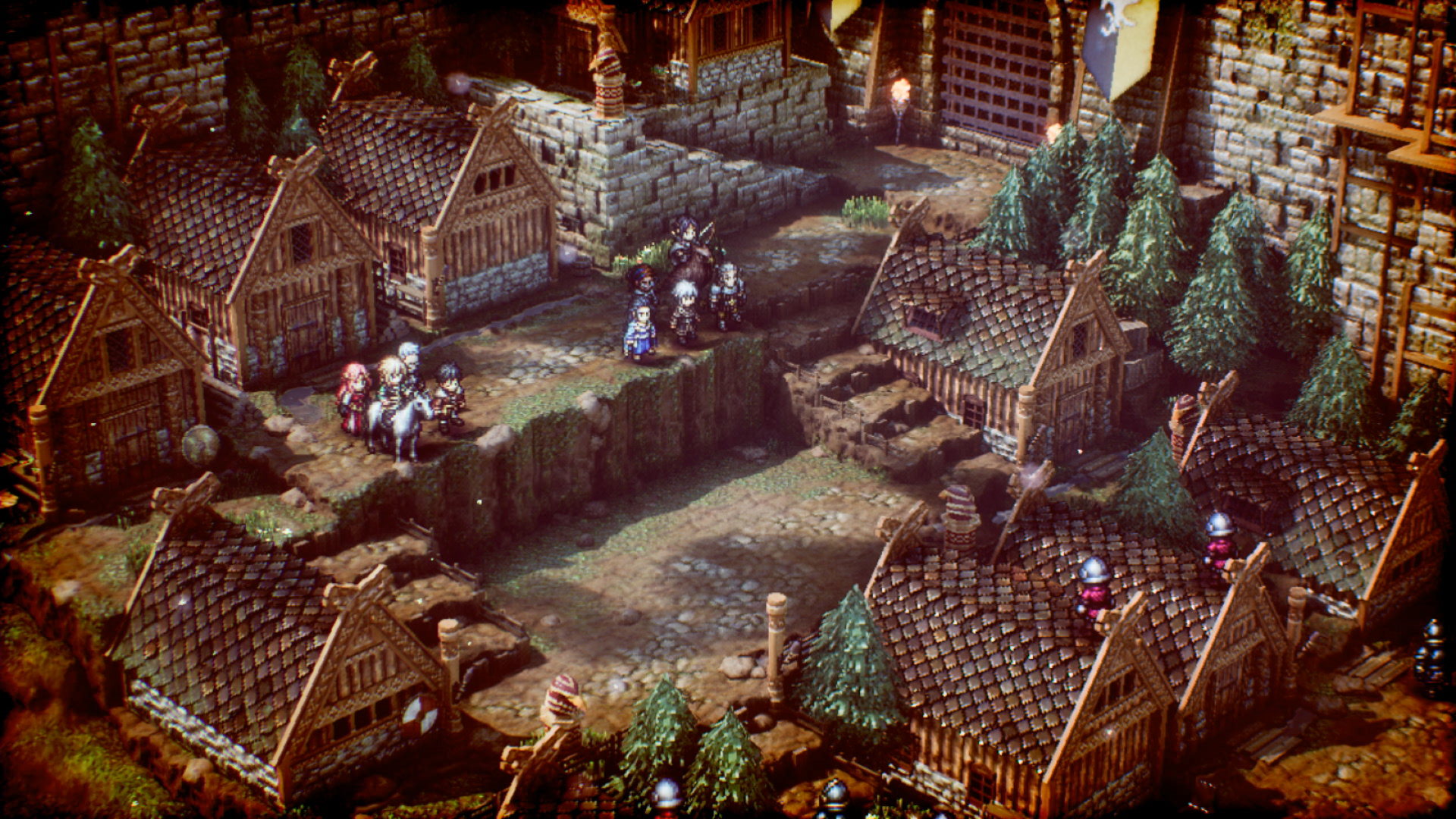
Remaining tactful against your mighty foes
When Triangle Strategy isn’t busy providing you with a sweeping story with thoughtful choices, it’s a turn-based tactics game. Battle upon battle is offered and what’s good to know is that none feel the same. At least part of this is due to the varied battlefields you’ll find yourself on. Piers, regional villages, regal cities, and even a mine complete with moving minecarts to get around are just some examples. It’s not hyperbole when I say that this is probably the most superb example of tactics maps that I’ve found myself in. Gone are the days of generic open fields with a team on each side. I never want to return to that genre trope ever again.
So many moving parts play a role in a battle. Positioning is absolutely key if you want your team to make it out alive. This counts both for how you’re situated around enemies and simply just which direction your party members are facing. After a character of yours takes a turn, you can choose which way they are facing. If an enemy gets up behind you they can deal critical backstabbing damage. Similarly, if a pair of foes is positioned on either side of one of your heroes, a follow-up attack will be performed by one after the other. There are ways around this as it becomes clear the defence strategy is to either have your back to a wall or be surrounded by allies in these tense moments. Though you too can use this against your enemies and would benefit greatly from doing so. Other expected elements such as bonus damage that comes from having the higher ground are also present, encouraging great use of the creative terrain around you.
At the bottom of the screen, you can see in order which opponent or ally is to attack. Careful consideration should be had here. If you foresee great damage coming a party member’s way, you can prioritise taking out the enemies that’ll attack next, or you can send Serenoa their way, using the Delaying Strike to boot that enemy’s turn further back in the timeline. This is but one example of some wonderful, exciting abilities to get stuck into.
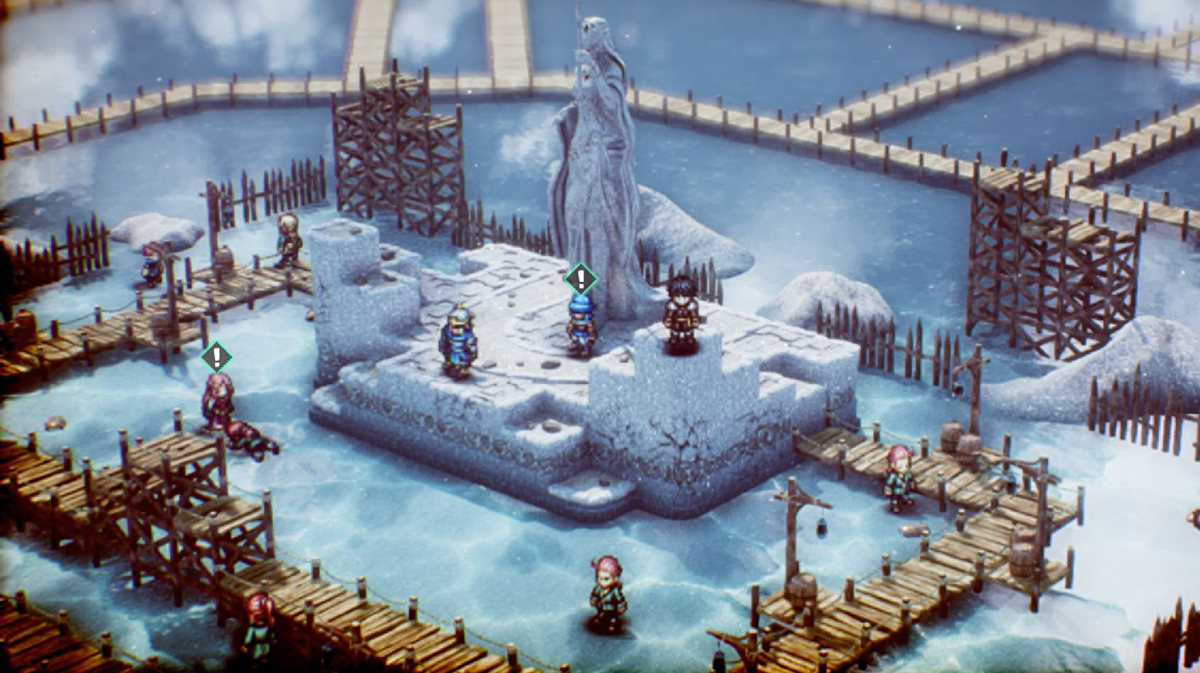
The abilities found in Triangle Strategy are but another way characters become well-distinguished in-game. There are no jobs or specialities to invest in for your team, instead, each character comes with their own pre-determined set of abilities they will unlock through levelling. I like this approach because now I’m not accidentally speccing too many characters under the same class, finding no rhyme or reason for picking any individual. Spend enough time and it becomes easier to identify which character you want for any given situation. Anna, the rogue character, is a viable teammate for a stealth approach thanks to her ability to vanish out of appearance only to pop up behind a soon-to-fall foe. One last shout-out has to be made to the mage characters. Be it fiery attacks from Princess Frederica Aesfrost or the shaman Medina raining down lightning on the battlefield, their hits are devastating both visually and physically, ripping across the map.
If you’re an RPG and levelling nerd, that is still on offer here too. An encampment you can access in between missions has plenty of opportunities to do so. Players can master characters, further unlocking deeper skills than those they’d get from normal levelling. Have enough coin and special materials and you can purchase passive upgrades such as a bolster to health, defence, damage or more, allowing for some granular differentiating to make almost mini-builds within your pre-determined character skillsets. Find yourself scarce of supplies or need a little more levelling? Mockup battles can be entered from the encampment as well. The encampment offers a welcome way to lengthen out your time with Triangle Strategy and get further into the nitty-gritty.
All of these factors make Triangle Strategy sound over-complex and needlessly difficult. Perhaps that’s what the game was one day fated to be. Since listening to demo feedback last year, however, varied difficulties have been included. Additionally, permadeath for your cast does not exist in combat, only in scripted cutscenes, lightening the pressure. This once more hones in on the undeniable fact that Triangle Strategy is a video game that is directly stemming from deep thought and consideration towards the fans. It’s tough at times, but at the end of the day, it’s clear the developers want you to just experience all the special tidbits the game has to show you. Dare I say it, this is a game matching if not higher than the majesty of the ever precious and beloved Final Fantasy Tactics.
Making the 2D HD
Like Octopath Traveler before it, Triangle Strategy sports what is now known as a ‘2D-HD’ art style. This essentially boils down to a game that has 2D sprites in a world with HD assets. As it’s still a more recent emerging art style, it’s hard not to be excited to soak in the environments around you. Characters will have that familiar pixel look from the SNES era while having all the more extra detailing. Lighting coming from moonlight, torches, or direct sunlight will feel somewhat photorealistic and dynamic, all the while offering a fantastical juxtaposition to the polygonal environmental and character assets.
All the tilework is immensely detailed on every castle wall or residential hut. Cracks in the boards of piers are visible. So much time and thought was put into the artistic design of Norzelia. Explorative moments provide ample opportunity to admire such work. Walking around this 3D plain, noting the diorama feel of every given environment, brings calming vibes and a sense of wonder. This is at times hampered – these explorative moments occasionally ask players to look for specific items in grassy areas. The only indication of such an item is a small shine, something easy to miss in the occasionally blurry imagery as you squint to search in any given spot. It’s not enough to ruin the magic that the environments bring, but it did leave frustration every so often.
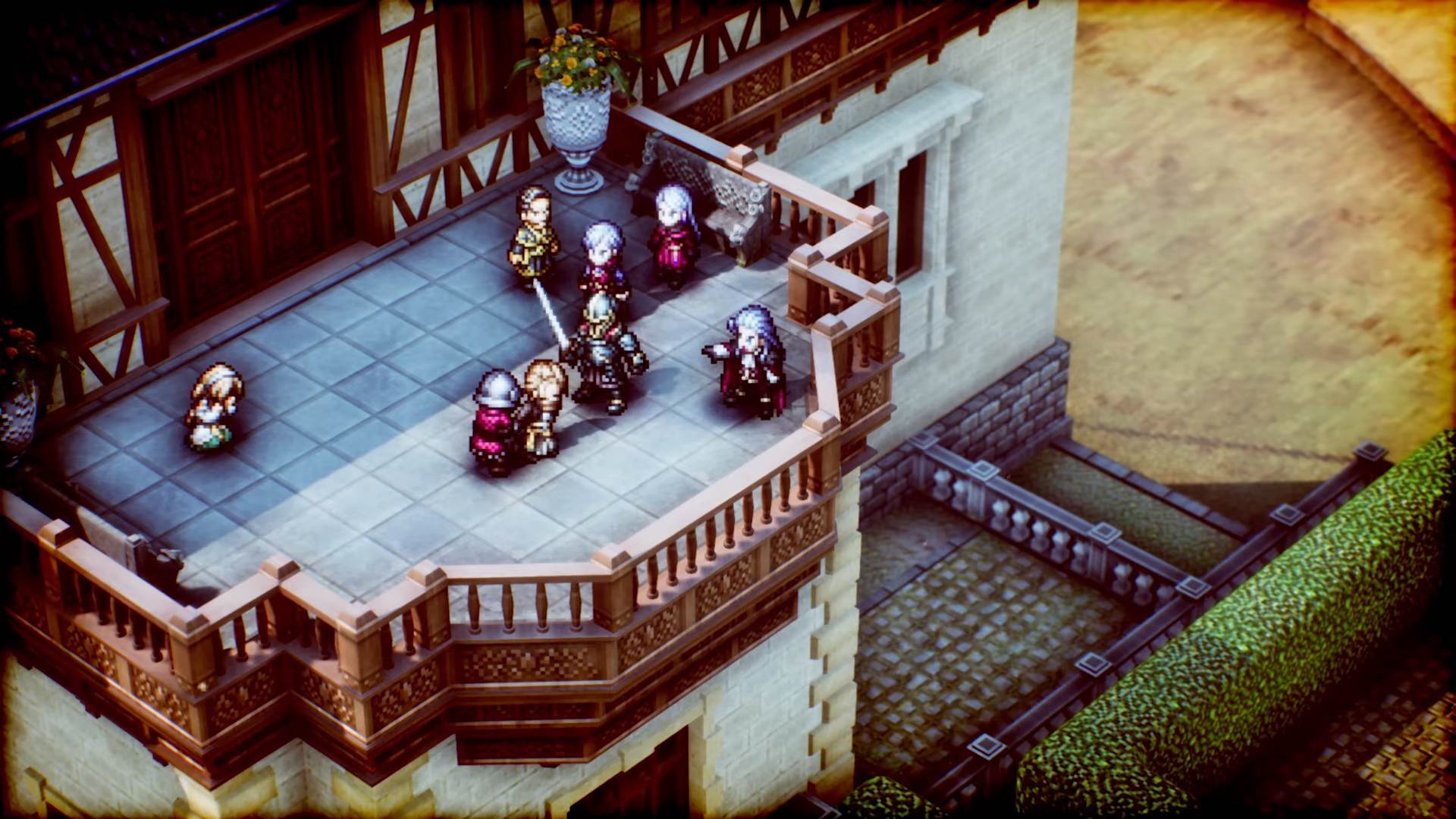
The good news for sticklers of this HD-2D art style is it looks like it’s here to stay with titles like Live A Live in the works. Triangle Strategy is but another strong offering in this growing niche, highlighting that the resurgence of creative and colourful RPGs is far from over. We’re in a hell of a renaissance for 2D video game art these days, folks. What a time to be alive.
9
Amazing
Positive:
- Sweeping and broad fantasy story with plenty of political tidbits.
- Distinguished characters with plenty of creative abilities to turn the tide in battle.
- Some of the best and most accessible tactics gameplay I've seen yet.
- Scale of Conviction makes for interesting means of branching paths.
- 2D-HD art style continues to blossom in this showcase.
Negative:
- Exploration moments leaves players a bit turned around at times.
We may be some time away from a new Final Fantasy Tactics, if ever. However, save the iconography, because Triangle Strategy is more or less that very experience that players have been looking for. It’s the most sweeping, expansive fantasy story I’ve played in some time, with plenty of engaging political intrigue that’ll whet many appetites. On offer is some of the best and most strategic tactics gameplay ever, rife with reward. So many setpieces, close call victories, and narrative moments will stick with me for some time. If you’re itching for a tactics game to amaze and move you this year, Triangle Strategy is it.
